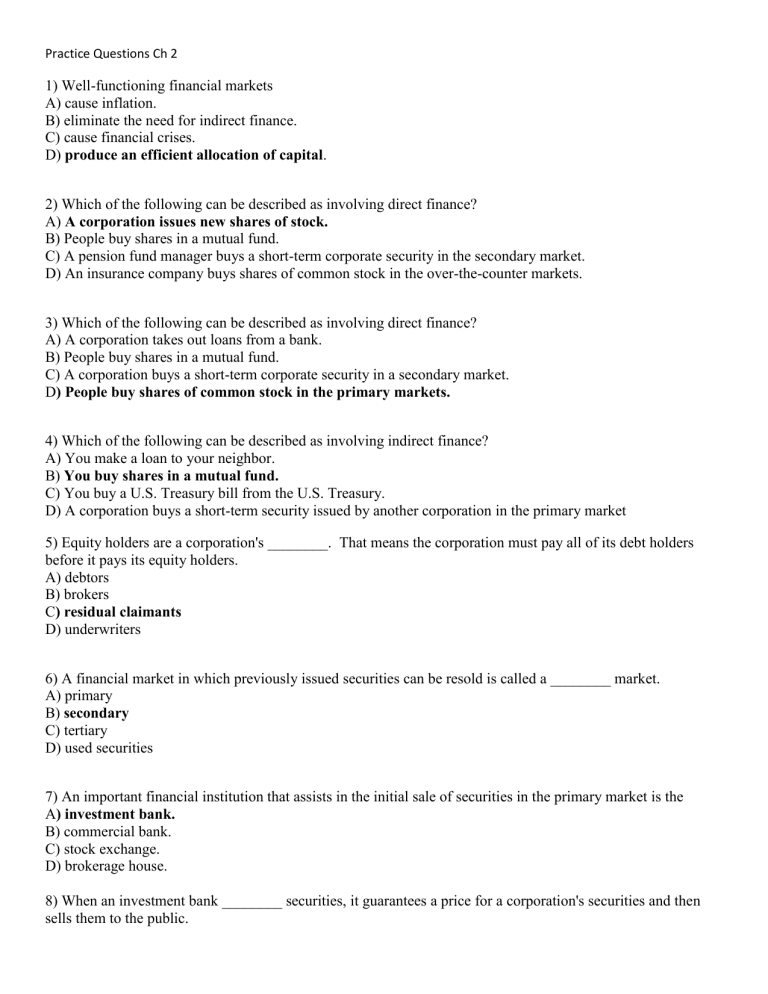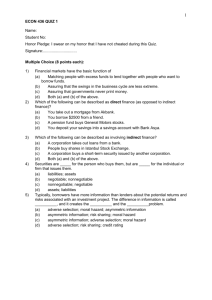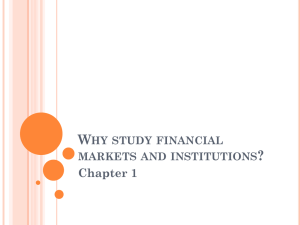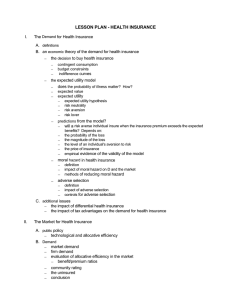
Practice Questions Ch 2 1) Well-functioning financial markets A) cause inflation. B) eliminate the need for indirect finance. C) cause financial crises. D) produce an efficient allocation of capital. 2) Which of the following can be described as involving direct finance? A) A corporation issues new shares of stock. B) People buy shares in a mutual fund. C) A pension fund manager buys a short-term corporate security in the secondary market. D) An insurance company buys shares of common stock in the over-the-counter markets. 3) Which of the following can be described as involving direct finance? A) A corporation takes out loans from a bank. B) People buy shares in a mutual fund. C) A corporation buys a short-term corporate security in a secondary market. D) People buy shares of common stock in the primary markets. 4) Which of the following can be described as involving indirect finance? A) You make a loan to your neighbor. B) You buy shares in a mutual fund. C) You buy a U.S. Treasury bill from the U.S. Treasury. D) A corporation buys a short-term security issued by another corporation in the primary market 5) Equity holders are a corporation's ________. That means the corporation must pay all of its debt holders before it pays its equity holders. A) debtors B) brokers C) residual claimants D) underwriters 6) A financial market in which previously issued securities can be resold is called a ________ market. A) primary B) secondary C) tertiary D) used securities 7) An important financial institution that assists in the initial sale of securities in the primary market is the A) investment bank. B) commercial bank. C) stock exchange. D) brokerage house. 8) When an investment bank ________ securities, it guarantees a price for a corporation's securities and then sells them to the public. A) underwrites B) undertakes C) overwrites D) overtakes 9) Which of the following is not a secondary market? A) foreign exchange market B) futures market C) options market D) IPO market 10) Secondary markets make financial instruments more A) solid. B) vapid. C) liquid. D) risky. 11) A debt instrument sold by a bank to its depositors that pays annual interest of a given amount and at maturity pays back the original purchase price is called A) commercial paper. B) a negotiable certificate of deposit. C) a municipal bond. D) federal funds. 12) A short-term debt instrument issued by well-known corporations is called A) commercial paper. B) corporate bonds. C) municipal bonds. D) commercial mortgages. 13) ________ are short-term loans in which Treasury bills serve as collateral. A) Repurchase agreements B) Negotiable certificates of deposit C) Federal funds D) U.S. government agency securities 14) Equity and debt instruments with maturities greater than one year are called ________ market instruments. A) capital B) money C) federal D) benchmark 15) If Microsoft sells a bond in London and it is denominated in dollars, the bond is a ________. A) Eurobond B) foreign bond C) British bond D) currency bond 16) An example of economies of scale in the provision of financial services is A) investing in a diversified collection of assets. B) providing depositors with a variety of savings certificates. C) spreading the cost of borrowed funds over many customers. D) spreading the cost of writing a standardized contract over many borrowers 17) Reducing risk through the purchase of assets whose returns do not always move together is A) diversification. B) intermediation. C) intervention. D) discounting. 18) Typically, borrowers have superior information relative to lenders about the potential returns and risks associated with an investment project. The difference in information is called A) moral selection. B) risk sharing. C) asymmetric information. D) adverse hazard 19) If bad credit risks are the ones who most actively seek loans and, therefore, receive them from financial intermediaries, then financial intermediaries face the problem of A) moral hazard. B) adverse selection. C) free-riding. D) costly state verification. 20) The problem created by asymmetric information before the transaction occurs is called ________, while the problem created after the transaction occurs is called ________. A) adverse selection; moral hazard B) moral hazard; adverse selection C) costly state verification; free-riding D) free-riding; costly state verification Short Answers Questions i) Corporations receive funds when their stock is sold in the primary market. Why do corporations pay attention to what is happening to their stock in the secondary market? Answer: The existence of the secondary market makes their stock more liquid and the price in the secondary market sets the price that the corporation would receive if they choose to sell more stock in the primary market. ii) Describe the two methods of organizing a secondary market. Answer: A secondary market can be organized as an exchange where buyers and sellers meet in one central location to conduct trades. An example of an exchange is the New York Stock Exchange. A secondary market can also be organized as an over-the-counter market. In this type of market, dealers in different locations buy and sell securities to anyone who comes to them and is willing to accept their prices. An example of an overthe-counter market is the federal funds market. iii) Distinguish between a foreign bond and a Eurobond. Answer: A foreign bond is sold in a foreign country and priced in that country's currency. A Eurobond is sold in a foreign country and priced in a currency that is not that country's currency. Ch 8 MULTIPLE CHOICE. Choose the one alternative that best completes the statement or answers the question. 1) Canadian businesses get their external funds primarily from 1) ________ _ A) loans from nonbank financial intermediaries. B) bank loans. C) bonds and commercial paper issues. D) stock issues. 2) The reduction in transactions costs per dollar of investment as the size of transactions increases is known as: A) discounting. B) economies of scale. C) diversification. D) economies of trade. 2) ________ _ 3) A borrower who takes out a loan usually has better information about the potential returns and risk of the investment projects he plans to undertake than does the lender. This inequality of information is called A) adverse selection. B) asymmetric information. C) moral hazard. D) noncollateralized risk. 3) ________ _ 4) The problem created by asymmetric information before the transaction occurs is called ________, while the problem created after the transaction occurs is called ________. A) free-riding; costly state verification B) adverse selection; moral hazard C) costly state verification; free-riding D) moral hazard; adverse selection 4) ________ _ 5) Of the following sources of external finance for Canadian nonfinancial businesses, the least important is A) bonds and commercial paper. B) loans from other financial intermediaries. C) stocks. D) loans from banks. 5) ________ _ 6) Collateralized debt is also know as 6) ________ _ A) promissory debt. C) unrestricted debt. B) secured debt. D) unsecured debt. 1) 2) 3) 4) 5) 6)B B B B B C B






